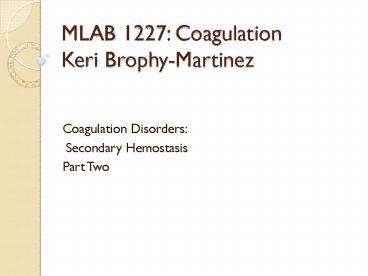MLAB 1227: Coagulation Keri Brophy-Martinez - PowerPoint PPT Presentation
1 / 20
Title:
MLAB 1227: Coagulation Keri Brophy-Martinez
Description:
Coagulation Disorders: Secondary Hemostasis Part Two * * * * * * * * * * * * * Acquired Coagulation Disorders Two or more factors generally affected, ... – PowerPoint PPT presentation
Number of Views:198
Avg rating:3.0/5.0
Title: MLAB 1227: Coagulation Keri Brophy-Martinez
1
MLAB 1227 CoagulationKeri Brophy-Martinez
- Coagulation Disorders
- Secondary Hemostasis
- Part Two
2
Acquired Coagulation Disorders
- Two or more factors generally affected, more
complicated - Bleeding from multiple sites
- More common than hereditary disorders
- Classification
- DIC
- Primary Fibrinogenolysis
- Liver Disease
- Vitamin K Deficiency
- Acquired Pathologic Inhibitors
3
1. DIC Disseminated Intravascular Coagulation
- Consumption Coagulopathy
- As fibrin is formed, clotting proteins and
naturally occurring inhibitors and platelets are
consumed faster than they are made - Thrombo-hemorrhagic disorder
- Clotting and lysing occurring in blood vessel, at
the same time - Life threatening
- Bleeding is the most apparent characteristic
- Initiating events are thrombotic, where material
enters circulation - Occurs due to lack of the negative feedback
mechanism - Affects young and elderly
4
DIC Triggers
- Obstetric usually due to major tissue damage
such as retained dead fetus, abruptio placentae,
or placenta previa - Acute leukemias Promyelocytic increase number
of granules released into circulation as cells
break down - Intravascular hemolysis ex transfusion
reaction - Massive trauma (especially crushing injuries),
burns, surgical procedures - Heat stroke
- Snake venoms
- Septicemias and infections viral, bacterial,
rickettsial, fungal, protozoan (especially gram
negative that release endotoxins) - Tumors foreign tissues and cells
- Prosthetic devices heart valves, aortic
balloon, peritoneal shunting - Vascular disease damaged endothelial lining
5
(No Transcript)
6
Course of DIC
7
DIC How Does It Occur?
- Step 1 Out of control clotting
- Causes widespread fibrin deposits in vessels of
tissues and organs - Subsequent event Hemorrhage
- Clotting proteins consumed at a high rate
- Causes multiple factor deficiencies, especially
fibrinogen group - Platelets caught in thrombi and removed
8
DIC How Does It Occur?
- Step 2 Triggers Fibrinolytic system to remove
fibrin - Results in
- Circulating degradation products that interfere
with platelet function normal clot formation - Degradation of Factor V VIII
9
DIC How Does It Occur?
- Step 3 Uncontrolled plasmin and thrombin enter
circulation - Why?
- Inhibitors such as AT have been depleted
10
DIC How Does It Occur?
- Step 4 Appearance of Symptoms
- Bleeding from multiple sites
- Petechiae
- Purpura
- Occlusions in organs
- Oozing from arterial lines, venipuncture sites
- Shock
11
Lab Features of DIC
- Platelet count decreased
- (40-75 x 109/L)
- PT increased
- PTT increased
- Fibrinogen decreased
- FDP /D-dimer positive
- Most helpful in diagnosis
- RBC fragments present
- AT decreased
12
DIC
- Treatment
- Goal is to treat the underlying condition
- Remove the triggering process treat with
antibiotics, antineoplasms, remove dead tissue,
treat the diseases or conditions - Heparin to prevent or limit further coagulation
- Replace factors, platelets give FFP
13
2. Primary Fibrinogenolysis
- Similar to DIC
- Plasminogen is inappropriately activated to
plasmin - Plasmin circulates overwhelming the antiplasmin
inhibitors and degrading fibrinogen and factors
V,VIII, XIII - No thrombin is generated
- Liver disease is a common trigger
14
3. Liver Disease
- Affects all proteins made in the liver that
function in fibrin formation, fibrinolysis and
inhibition. - Patients show minimal bleeding, except in severe
cases - Lab features
- Increased
- PT,PTT
- Decreased
- Platelets
15
4. Vitamin K Deficiency
- Liver cells able to make precursor protein but
the calcium binding site is nonfunctional - Causes
- Malabsorptive syndromes
- Sprue
- Obstruction in biliary tract
- Antibiotic therapy
- Kills off normal flora in gut which made vitamin K
16
5. Acquired Pathologic Inhibitors
- Develop in patients with certain disease states
and others with no underlying conditions - Circulating anticoagulants which may develop
against any clotting factor - Classed as immunoglobulins
- Either IgG or IgM
- Can be alloantibodies or autoantibodies
- Not normally synthesized by the body, bind with
the factors making them unavailable for use in
the cascade
17
Types of Inhibitors
- Directed towards a single coagulation factor
- Seen in patients with inherited factor
deficiencies that have had replacement therapy
for bleeding complications - Less commonly seen in healthy people and those
taking certain drugs - Rare, except Factor VIII IX
- How do we find them?
- Interfere with clotting factor activity
- PTT prolonged, other tests normal
- Mixing study test will still be prolonged
18
Types of Inhibitors
- Lupus Inhibitor/Anticoagulant
- Seen in patients with autoimmune diseases, drug
reactions, but also in normal patients - Autoantibodies interfere with phospholipid-depende
nt reagents used in PTT tests - Patients have no bleeding problems (though some
have an increase risk of thrombosis) - In vitro, any coag test using a phospholipid
reagent will be falsely prolonged (PT, PTT) - Coag studies must be performed using reagents
that do not contain phospholipids
19
Comparison of Acquired Disorders
Test DIC Primary Fibrinogenolysis Severe Liver Disease Vitamin K Deficiency Factor Inhibitor Lupus Anticoagulant
Platelet Count Dec Normal Dec Normal Normal Normal
PT Inc Inc Inc Inc Normal, except VII inhibitor Normal
APTT Inc Inc Inc Inc Inc Inc
Fibrinogen Dec Dec Dec Normal Normal Normal
D-dimer Inc Normal Normal Normal Normal Normal
Plasminogen Dec Dec Normal-dec Normal Normal Normal
Antithrombin Dec Normal Dec Normal Normal Normal
Blood Smear Fragments Normal Macrocytes Targets, acanthocytes Normal Normal Normal
20
References
- McKenzie, Shirlyn B., and J. Lynne. Williams.
"Chapter 32." Clinical Laboratory Hematology.
Boston Pearson, 2010. Print.































